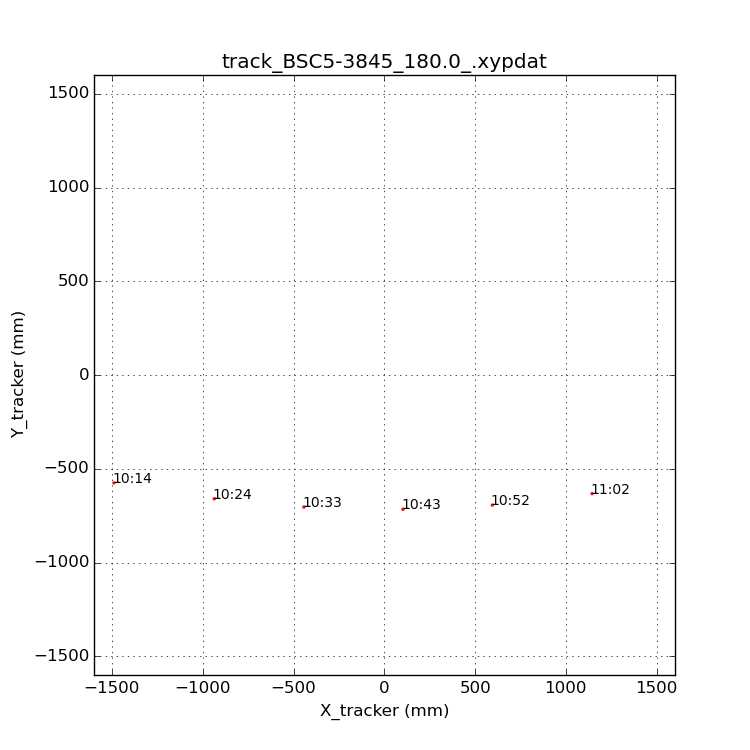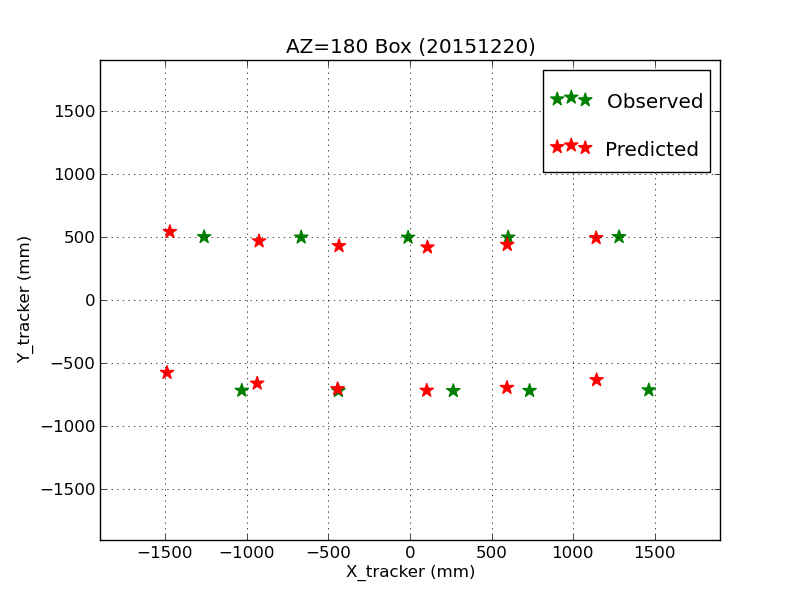ybsc_skyhex
Query the Yale Bright Star Catalog (YBSC) for stars that
can be observed at a fixed HET structure azimuth (AZ). This
is actually a faily general problem. I used this code (slightly
cleaned up and debugged) in Dec2105 to conduct some "Box Test"
observations with the HET. The ability to easily select appropriate
stars for this exercise was fulfilled with ybsc_skyhex. Below
I describe how this was done (including the use of some other
unrelated scripts).
To generate track files:
% ybsc_skyhex.sh 180
**** NOTE: A few straight-forward interactive queries must be answered.
To impose helpful star selection rules, and
to specify the UT Date/Time for when you want to make the observations:
*** Use skyhex.in (or edit slightly)
Sample skyhex.in file:
% cat skyhex.in
48.0 59.0 ALT(min,max)
150.0 210.0 AZ(min,max)
0.0 Tel_AZ offset
-1800.0 1800.0 X_STRT(min,max)
-1800.0 +1800.0 Y_STRT(min,max)
10:00:00 20151220 UT,UTdate
Desired mirror
In 5-10 seconds you will have generated a set of track files (track*.xypdat) and
a summary file named YBSC.list1 that lists the properties of the stars you have gathered:
% ls -1
track_BSC5-3741_180.0_.xypdat
track_BSC5-3750_180.0_.xypdat
track_BSC5-3758_180.0_.xypdat
track_BSC5-3759_180.0_.xypdat
track_BSC5-3760_180.0_.xypdat
track_BSC5-3762_180.0_.xypdat
track_BSC5-3787_180.0_.xypdat
track_BSC5-3814_180.0_.xypdat
track_BSC5-3845_180.0_.xypdat *** The one we choose!
track_BSC5-3899_180.0_.xypdat
track_BSC5-3901_180.0_.xypdat
track_BSC5-3981_180.0_.xypdat
track_BSC5-4059_180.0_.xypdat
track_BSC5-4082_180.0_.xypdat
track_BSC5-4109_180.0_.xypdat
track_BSC5-4116_180.0_.xypdat
track_BSC5-4119_180.0_.xypdat
YBSC.list1
% cat track_BSC5-3845_180.0_.xypdat
# data
9
Xstrt
Ystrt
Xhet
Yhet
UT_real
UT
point_color
point_type
point_size
-1471.6 540.0 -0.6792 0.2289 9.85000 09:51 green circle 1.0000
-924.9 466.2 -0.4277 0.1994 10.01667 10:01 red solid-star 2.3000
-435.3 428.1 -0.2025 0.1842 10.16667 10:10 red solid-star 2.3000
107.2 417.8 0.0471 0.1801 10.33333 10:20 red solid-star 2.3000
596.1 437.6 0.2720 0.1880 10.48333 10:29 red solid-star 2.3000
1140.9 491.4 0.5226 0.2095 10.65000 10:39 red solid-star 2.3000
% cat YBSC.list1
Selection Rules:
ALT(min,max) in degrees: 48.00 59.00
AZ(min,max) in degrees: 150.00 210.00
Tel_AZ offset in degrees: 0.00
X_STRT min,max: -1800.0 1800.0
Y_STRT min,max: -1800.0 1800.0
YBSC Stars selected for UT=11:00:00 20151220
Desired mirror =
Nmirr = total number of ANY mirrors visible AFTER UT
Nwant = number of times DESIRED MIRROR is visible (1)
Ns = number of track points from START to UT (2)
Ne = number of track points from UT to END
Special Notes:
(1) Nwant tallies "requested mirror" hits ONLY for times
after the request UT (i.e. not the entire track).
(2) Ns/Ne just tells you how much track remains after UT
name RA_2000 DEC_2000 AZ ALT Xmm Ymm U_mag col Tel_AZ Nmirr Nwant Ns Ne
BSC5-3741 09:26:22.30 -01:27:50.0 194.98 56.96 1778 -448 8.77 10.7 180.0 0 0 0 0
BSC5-3750 09:27:46.80 -06:04:16.0 192.73 52.52 1687 517 6.15 10.5 180.0 0 0 0 0
BSC5-3758 09:29:02.20 -01:15:25.0 193.86 57.30 1630 -523 6.65 10.4 180.0 0 0 0 0
BSC5-3759 09:29:08.90 -02:46:08.0 193.26 55.83 1621 -202 5.06 10.4 180.0 0 0 0 0
BSC5-3760 09:29:24.50 -02:12:19.0 193.34 56.39 1608 -325 6.52 10.3 180.0 0 0 0 0
BSC5-3762 09:29:32.40 -04:14:50.0 192.59 54.39 1596 109 7.50 10.3 180.0 0 0 0 0
BSC5-3787 09:31:58.90 -01:11:06.0 192.54 57.52 1467 -570 4.76 10.0 180.0 0 0 54 0
BSC5-3814 09:34:32.70 -05:54:54.0 190.04 52.96 1317 421 7.85 9.6 180.0 0 3 51 3
BSC5-3845 09:39:51.40 -01:08:34.0 188.92 57.87 1033 -648 6.69 9.0 180.0 0 8 46 8
BSC5-3899 09:51:14.00 -04:14:36.0 183.29 55.04 410 -31 6.29 7.5 180.0 0 19 34 19
BSC5-3901 09:51:21.60 -06:10:54.0 183.07 53.11 402 389 7.11 7.4 180.0 0 20 34 20
BSC5-3981 10:07:56.30 -00:22:18.0 175.57 58.89 -498 -868 4.38 5.3 180.0 0 36 18 36
BSC5-4059 10:19:32.20 -05:06:21.0 171.21 53.88 -1127 220 7.87 3.8 180.0 0 48 6 48
BSC5-4082 10:23:26.50 -04:04:27.0 169.30 54.76 -1343 28 5.70 3.3 180.0 0 52 2 52
BSC5-4109 10:28:44.00 -03:44:33.0 166.94 54.86 -1636 8 6.14 2.6 180.0 0 0 0 0
BSC5-4116 10:29:28.70 -02:44:21.0 166.27 55.80 -1679 -197 5.03 2.5 180.0 0 0 0 0
BSC5-4119 10:30:17.50 -00:38:13.0 165.09 57.81 -1728 -634 4.43 2.4 180.0 0 0 0 0
To view plots for the selected stars:
For a single file:
% pht.py track_BSC5-3845_180.0_.xypdat 10
The code pht.py is currently maintained in: sco/codes/python/virusP/pht.py
To view and print plots:
% ls -1 trac*data >Tlist
% pht_list Tlist
Once a source is selected for use, get the Ra,Dec from the file
YBSC.list1, and send it to the TO with:
Recall, with negative decs:
[sco@mcs]$ newtarg 09:39:51.40 -01:08:34.0 180.0
As an aside, when we take our observations with the acm, we can always
learn the last image taken with:
% lastim 20151220
 |
|
The HET tracker positions (X_tracker, Y_tracker in mm units) for
the BSC5-3845 on 20151220 when this star is being observed at
AZ=180 around 10:00UT. Each point is accompanied with a text label
that gives the UT time that the star will be at this position.
|
 |
|
Some results from my AZ=180 box test of 20151220..
I did two stars through the clouds. The green stars
are the Observed tracker X,Y positions taken from
the "d" dump we usually do. The red stars are the
Predicted positions made with the tool "ybsc_skyhex".
This tool extracted sets of track predictions for
Yale Bright Star catalog targets that could be
obsereved at AZ=180 aroun 10:00UT. For each star I
had a plot of X,Y that gave the UT time for each point.
The attached plot shows that this scheme works quite
well. The predicted points agree quite well with the
obsrved points. I could use the predicted UT times to
estimat when i should observe each star in the box test.
This procedure seemed to be smooth and easy to manage.
|
Back to SCO CODES page

